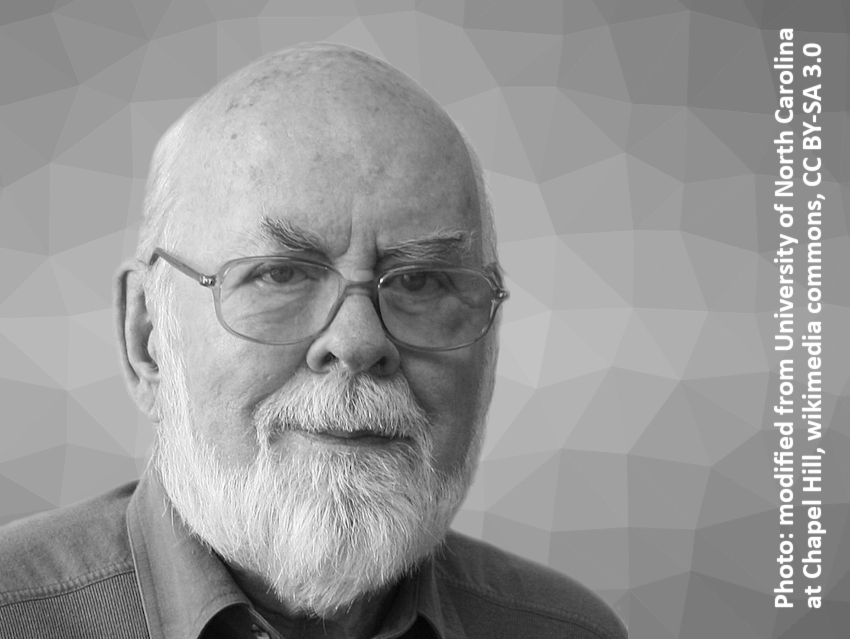Robert Ghormley Parr was born on September 22, 1921, in Chicago, IL, USA. He studied chemistry at Brown University, Providence, RI, USA, and at the University of Minnesota, USA, where he received his Ph.D. in 1947. He became Assistant Professor of Chemistry at the University of Minnesota in 1947 and moved to the Carnegie Institute of Technology, Pittsburgh, PA, USA, in 1948. He was promoted to Professor of Chemistry there and remained at the Institute until 1962.
Parr then served as a Visiting Professor of Chemistry and Member of the Center of Advanced Study at the University of Illinois, USA, and joined Johns Hopkins University, Baltimore, MD, USA, as Professor of Chemistry in 1962. He became William R. Kenan, Jr. Professor of Theoretical Chemistry at the University of North Carolina (UNC) at Chapel Hill, USA, in 1974 and Wassily Hoeffding Professor of Chemical Physics there in 1990. He remained at UNC for the rest of his career. Robert Ghormley Parr died on March 27, 2017, in Chapel Hill, NC, USA.
Parr was a Member of the International Academy of Quantum Molecular Science, the U.S. National Academy of Sciences, the American Academy of Arts and Sciences, and the Indian National Science Academy. Among many other honors, he received the Outstanding Achievement Award of the University of Minnesota in 1968, the North Carolina Institute of Chemists Distinguished Chemist Award in1982, the Irving Langmuir Award in Chemical Physics from the American Chemical Society (ACS) in 1994, and the National Academy of Sciences Award in Chemical Sciences in 2004.
Parr was a well-known theoretical chemist and co-authored one of the most highly cited chemistry papers of all time [1]. His research dealt with ab initio and semiempirical quantum chemistry methods. He developed a method for computing approximate molecular orbitals for π-electron systems together with Rudolph Pariser, which was published in 1953 [2,3]. John Pople proposed the same approximation, also in 1953 [4], and the approach is known as the Pariser–Parr–Pople or PPP method.
In 1988, Parr developed a correlation functional that is very widely used in density functional theory (DFT) together with Weitao Yang and Chengteh Lee, called LYP for “Lee–Yang–Parr” [1]. It approximates the energy of electrons in a system that stems from their correlated movement. LYP is very widely used, e.g., as part of the B3LYP exchange-correlation functional, a popular DFT method. The paper reporting the LYP functional, thus, has tens of thousands of citations (ca. 78,500 as of September 2021 [5]).
Robert G. Parr is the answer to Guess the Chemist (117).
References
- [1] Development of the Colle-Salvetti correlation-energy formula into a functional of the electron density,
Chengteh Lee, Weitao Yang, Robert G. Parr,
Phys. Rev. B 1988, 37, 785–789.
https://doi.org/10.1103/PhysRevB.37.785 - [2] A Semi‐Empirical Theory of the Electronic Spectra and Electronic Structure of Complex Unsaturated Molecules. I.,
Rudolph Pariser, Robert G. Parr,
J. Chem. Phys. 1953, 21, 466–471.
https://doi.org/10.1063/1.1698929 - [3] A Semi‐Empirical Theory of the Electronic Spectra and Electronic Structure of Complex Unsaturated Molecules. II,
Rudolph Pariser, Robert G. Parr,
J. Chem. Phys. 1953, 21, 767–776.
https://doi.org/10.1063/1.1699030 - [4] Electron interaction in unsaturated hydrocarbons,
J. A. Pople,
Trans. Faraday Soc. 1953, 49, 1375.
https://doi.org/10.1039/TF9534901375 - [5] according to Web of Science, Clarivate
Sources
- Robert G. Parr (1921–2017),
Paul Ayers, Weitao Yang,
Angew. Chem. Int. Ed. 2017, 56, 10639–10639.
https://doi.org/10.1002/anie.201705477
Selected Publications
- Density functional approach to the frontier-electron theory of chemical reactivity,
Robert G. Parr, Weitao Yang,
J. Am. Chem. Soc. 2002, 106, 4049–4050.
https://doi.org/10.1021/ja00326a036 - Absolute hardness: companion parameter to absolute electronegativity,
Robert G. Parr, Ralph G. Pearson,
J. Am. Chem. Soc. 2002, 105, 7512–7516.
https://doi.org/10.1021/ja00364a005 - Electrophilicity Index,
Robert G. Parr, László v. Szentpály, Shubin Liu,
J. Am. Chem. Soc. 1999, 121, 1922–1924.
https://doi.org/10.1021/ja983494x - Density Functional Theory of Electronic Structure,
W. Kohn, A. D. Becke, R. G. Parr,
J. Phys. Chem. 1996, 100, 12974–12980.
https://doi.org/10.1021/jp960669l - Density-Functional Theory for Fractional Particle Number: Derivative Discontinuities of the Energy,
John P. Perdew, Robert G. Parr, Mel Levy, Jose L. Balduz,
Phys. Rev. Lett. 1982, 49, 1691–1694.
https://doi.org/10.1103/PhysRevLett.49.1691 - Electronegativity: The density functional viewpoint,
Robert G. Parr, Robert A. Donnelly, Mel Levy, William E. Palke,
J. Chem. Phys. 1978, 68, 3801–3807.
https://doi.org/10.1063/1.436185



